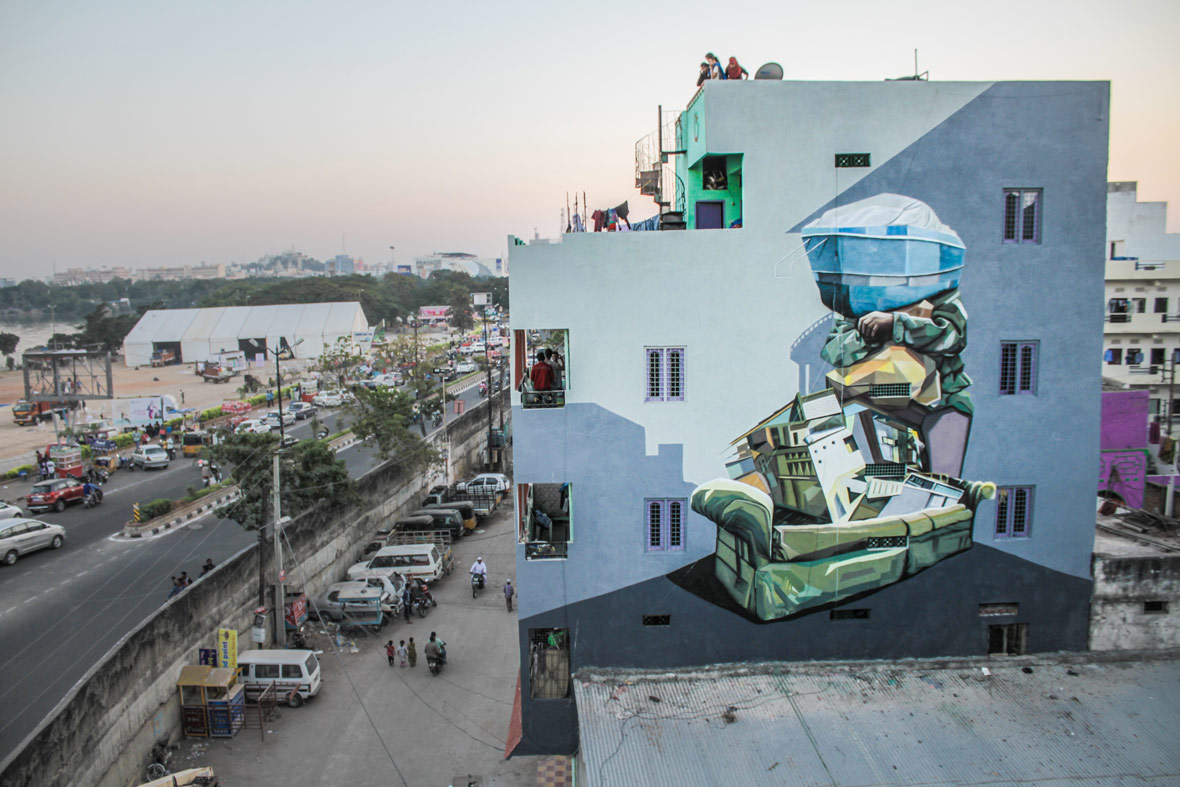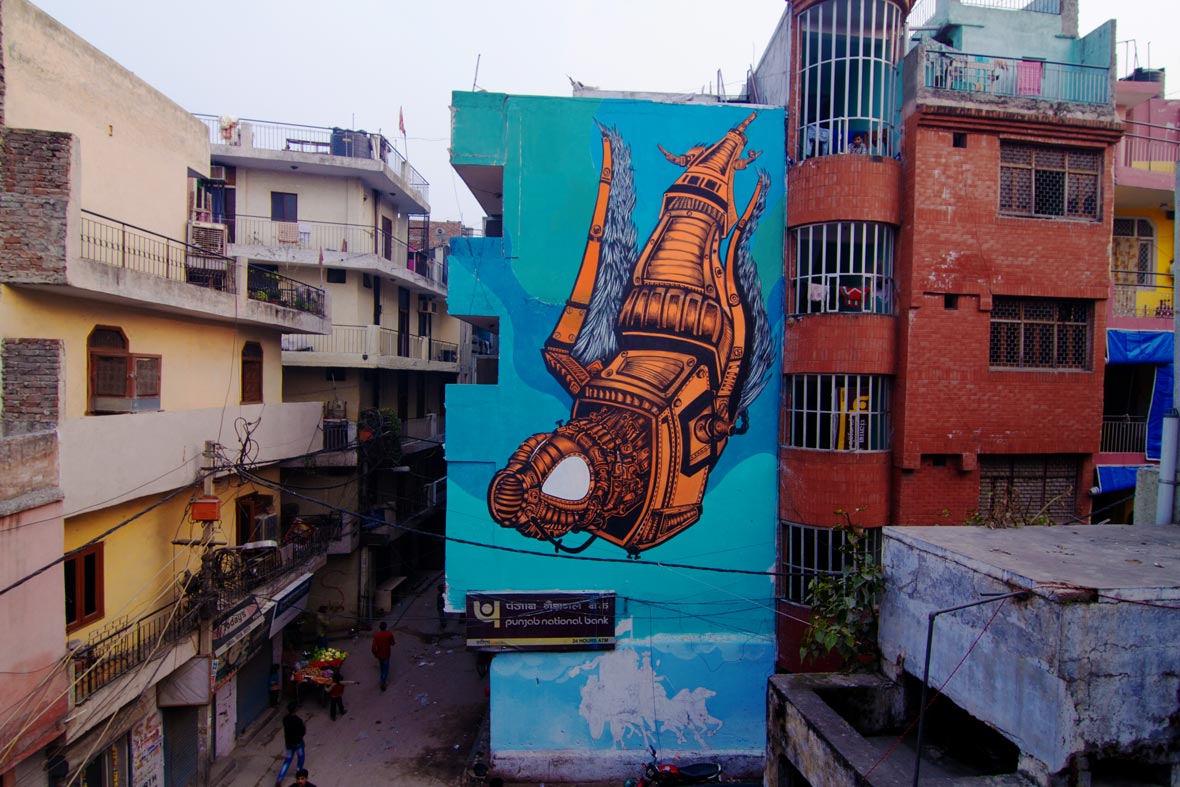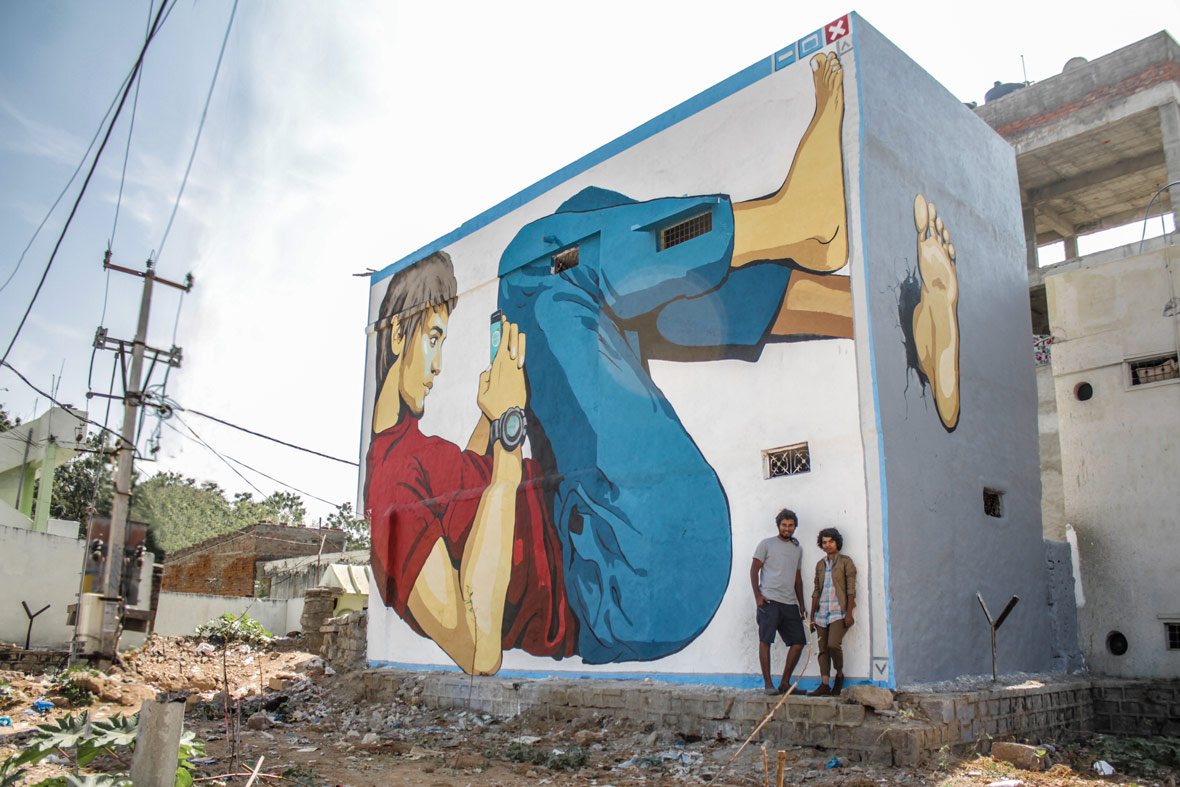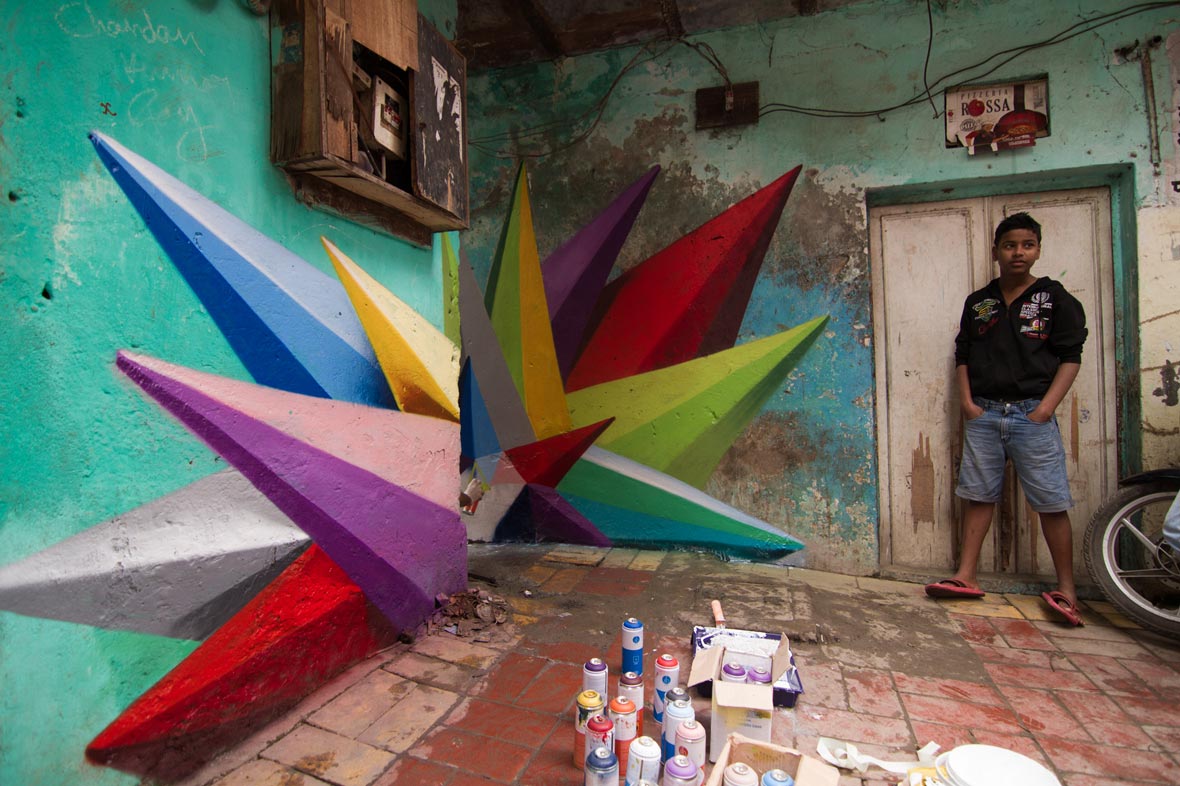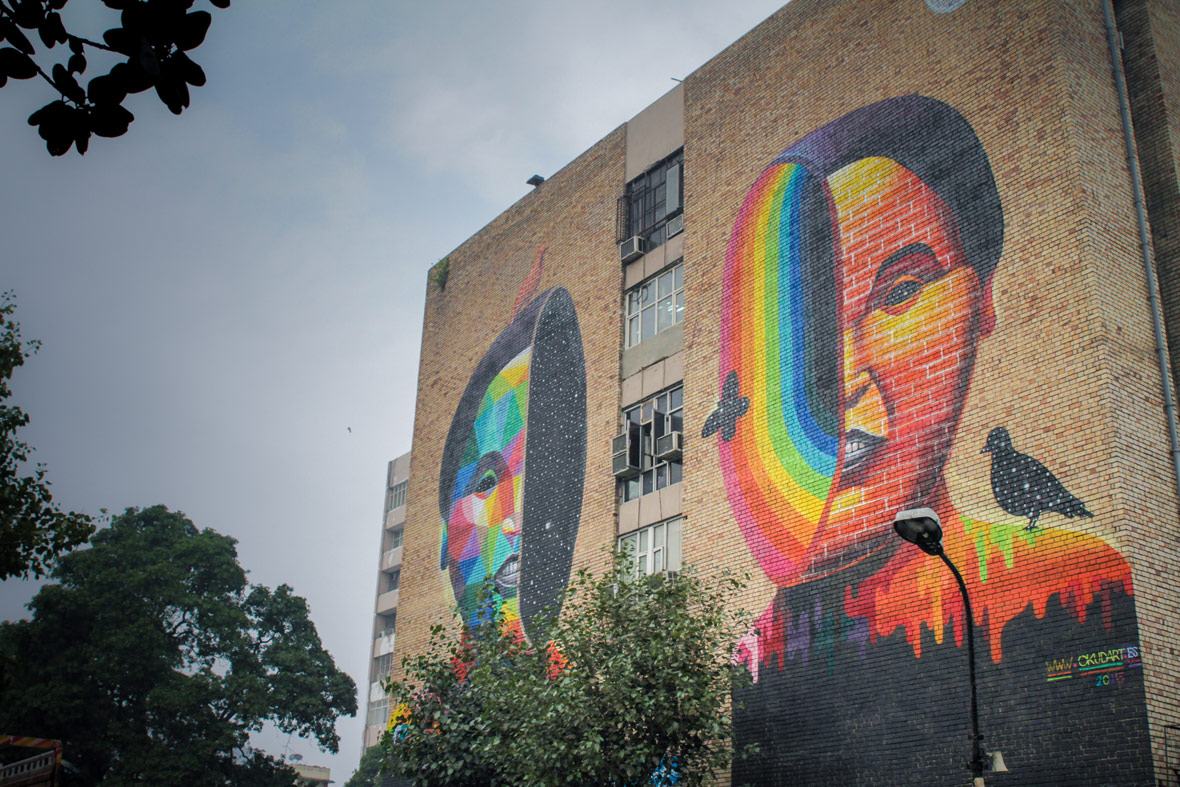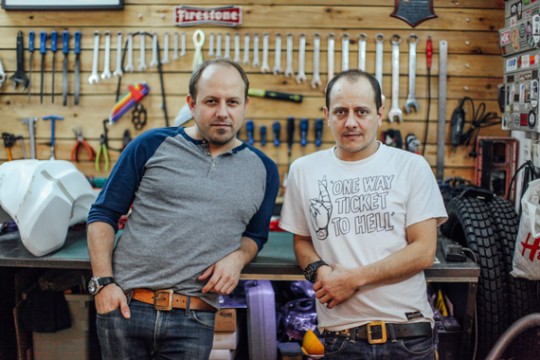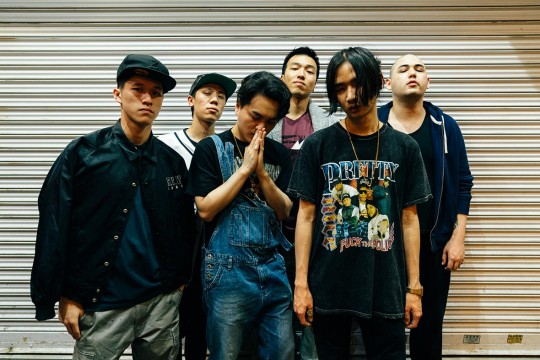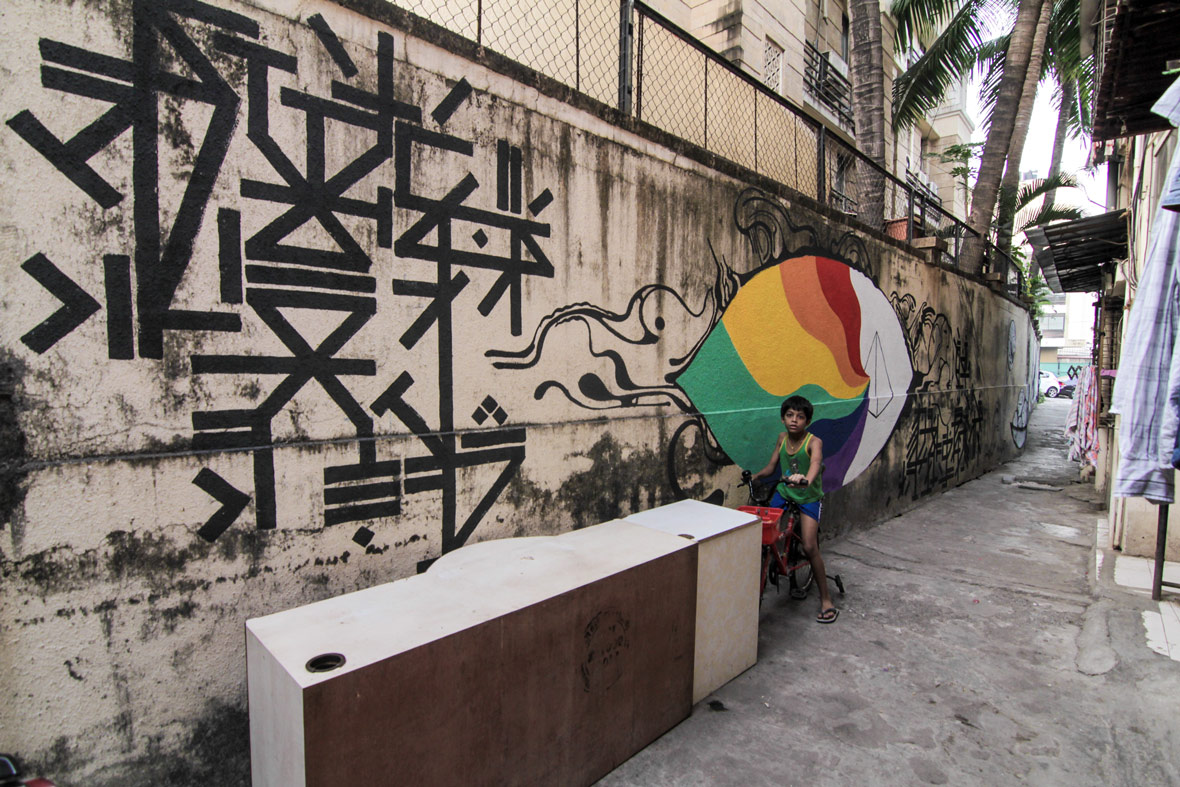
For many countries, graffiti is viewed in a negative light, often regarded as distasteful acts of vandalism. In India, this isn’t quite the case. Defacing property is, of course, illegal, but people in India have become much more receptive to street art. Many will take up artists on their offers of having their walls painted, seeing it as receiving a beautiful piece of art for free. But even with societal acceptance, graffiti still isn’t considered as a conventional form of art. And thus, the street art scene remained fairly underdeveloped and stagnant. But 2014 became a milestone year for the scene – This was the year that India saw its first-ever street art festival
在许多国家,人们对街头涂鸦的看法一直都比较负面。街头涂鸦往往被视为令人反感的破坏公物行为。而在印度情况却恰恰相反,当然破坏公物依然是违法的行为,但印度的人们对街头艺术却越来越包容;还有很多人甚至会邀请艺术家在他们的墙面上涂鸦,认为这算是免费获赠了一件美丽的艺术作品。但即使社会愿意包容,涂鸦仍被认为是一种非传统的艺术形式。因此,街头艺术在印度依然缺少发展,也并未受到重视。但2014年却成为了街头艺术发展的里程碑——印度举办了国内首个街头艺术节。
The 2014 festival, dubbed as St+art Delhi, was organized by Hanif Kureshi, Akshat Nauriyal, Arjun Bahl, Thanish Thomas and Giulia Ambrogi, who all come from different backgrounds. They were united by their love of alternative cultures and a shared interest in wanting to provide people in India a different way to experience art by making it interactive and approachable. The enthusiastic response to the 2014 festival led the five Delhi-based vanguards of creativity to form the St+art India Foundation, a not-for-profit organization that serves as a platform to advance their vision of making art accessible to the public and helps give voice to emerging artists. “[St+art Delhi 2014] was born out of a collective exhaustion from gallery spaces in general and the realization of the immense potential in making art public,” says Giulia Amborgi, festival curator for St+art India. “We saw an opportunity and did the first project without thinking about what comes next.”
来自不同文化背景的创意人Hanif Kureshi, Akshat Nauriyal, Arjun Bahl, Thanish Thomas 和 Giulia Ambrogi共同举办了德里街头艺术节-- St+art Delhi 2014。他们因为热爱非主流文化而走在一起,他们都渴望能通过更有互动性和更易接触的艺术来为印度的人们带来一种全新的艺术体验。他们在2014年创办的街头艺术节反响十分热烈,因此,这五名生活在德里的创意先驱又成立了一个非盈利组织St+art India Foundation作为平台推广他们的理念——创造更贴近大众的艺术,帮助新兴艺术家发声。St+art India的策展人Giulia Ambrogi表示:“St+art Delhi 2014源于我们对传统画廊空间的厌倦,我们意识到,在公共场合创作艺术有着巨大潜力。看到了这样一个机会后,我们马上就着手开始了第一个项目,也没有多想下一步要做什么。”

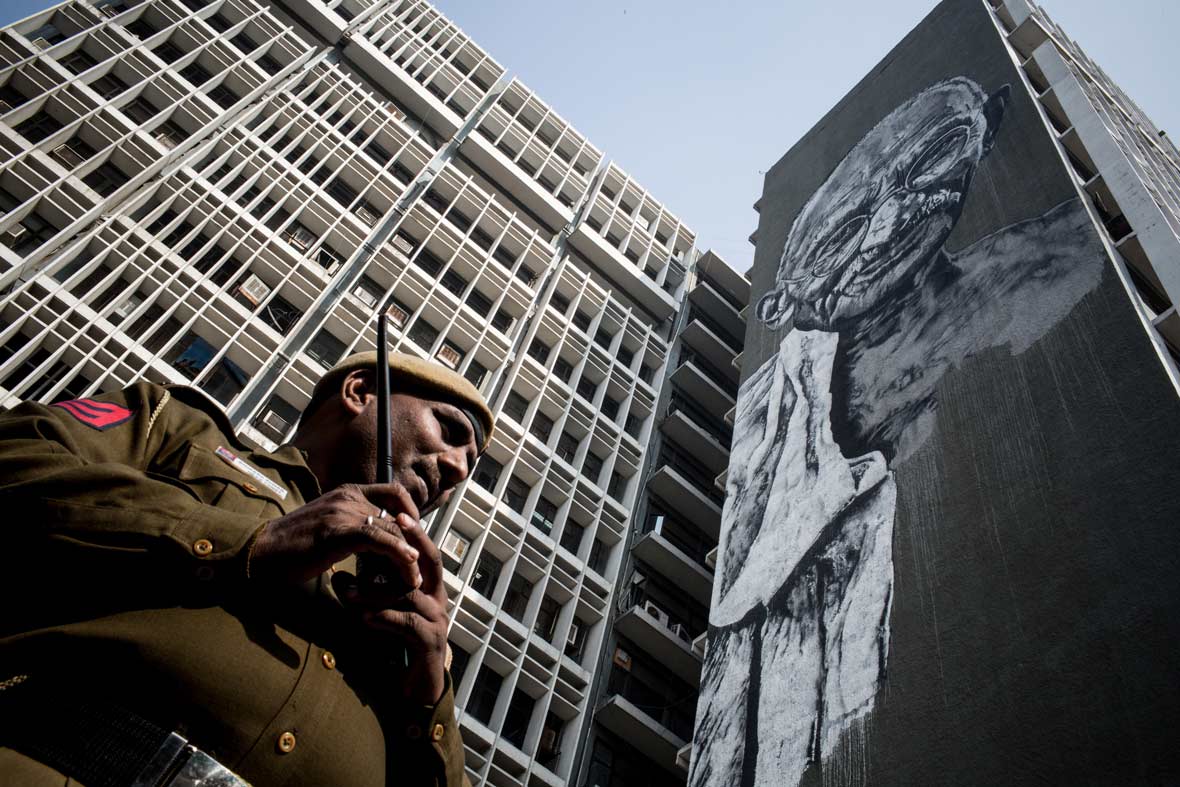
The first mural St+art introduced to Delhi in 2014 was a large-scale mural of Gandhi, which was painted on the facade of the Delhi Police Headquarters. Created by German street artist ECB (aka Hendrik Beikirch) and local artist Anpu Varkey, this piece became the bedrock of their amicable relationship with the Indian government. “We always try to make sure that the images an artist works on are respectful towards the cultural concepts and the many taboos – especially those related to religion – that are embedded in Indian culture,” says Ambrogi. “Therefore, there have been very few occasions of any real problems or resistance by the public. In fact, most of the time what happens is the opposite.” As part of 2016’s St+art Delhi, they even worked together with the Minister of Urban Development and turned New Delhi’s long-neglected Lodhi Colony into India’s first public art district.
St+art于2014年在德里推出的第一幅涂鸦作品是一幅巨型的甘地肖像,画在了德里警察总部外墙上。这幅由德国街头艺术家 ECB (即 Hendrik Beikirch)与当地艺术家Anpu Varkey创作的涂鸦作品成为了他们与印度政府建立友好关系的基石。Ambrogi说:“我们总是努力确保艺术家所创作的作品的图像能够尊重印度当地根深蒂固的文化概念和许多禁忌,尤其是与宗教有关的问题。因此,我们一直很少遇到大的问题,或有来自公众的抗议。事实上,大多数会发生的情况恰好相反。在 2016 的 St+art Delhi 街头艺术节,他们甚至与城市发展部部长合作,将新德里长期被忽视的Lodhi Colony 地区改造成为印度的第一个公共艺术区域。
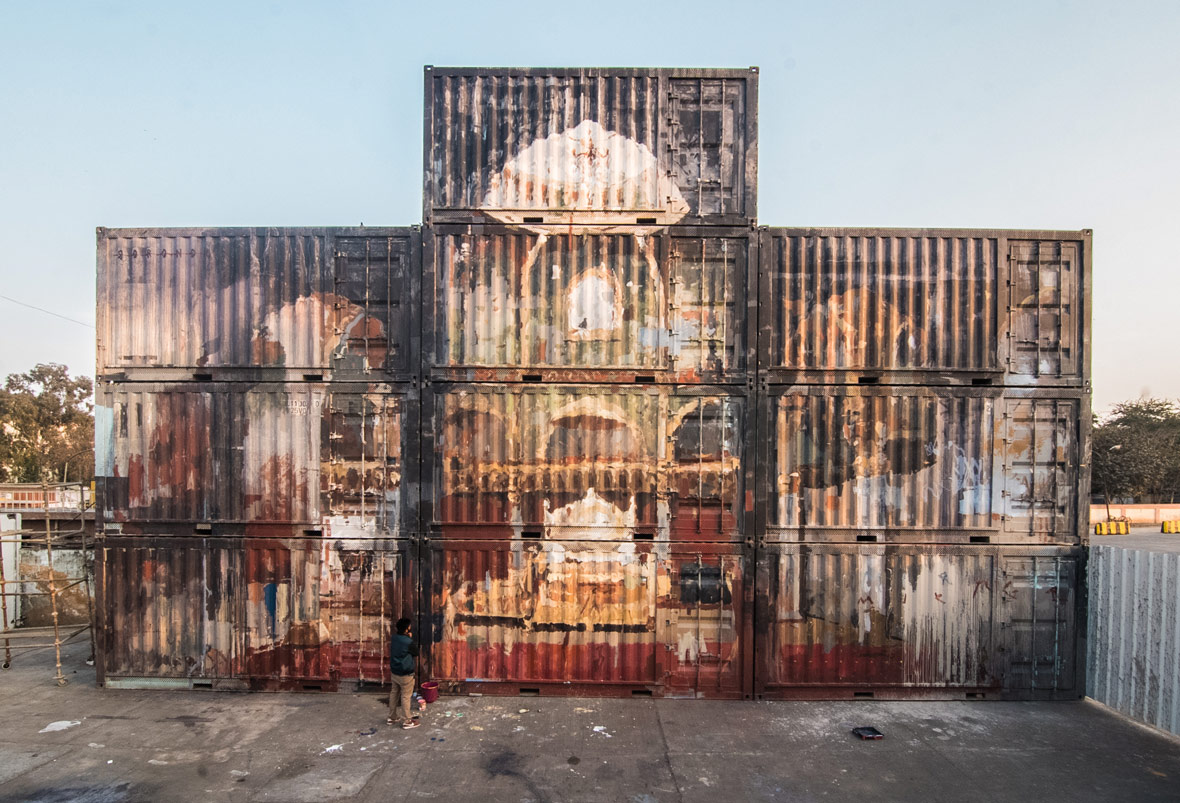
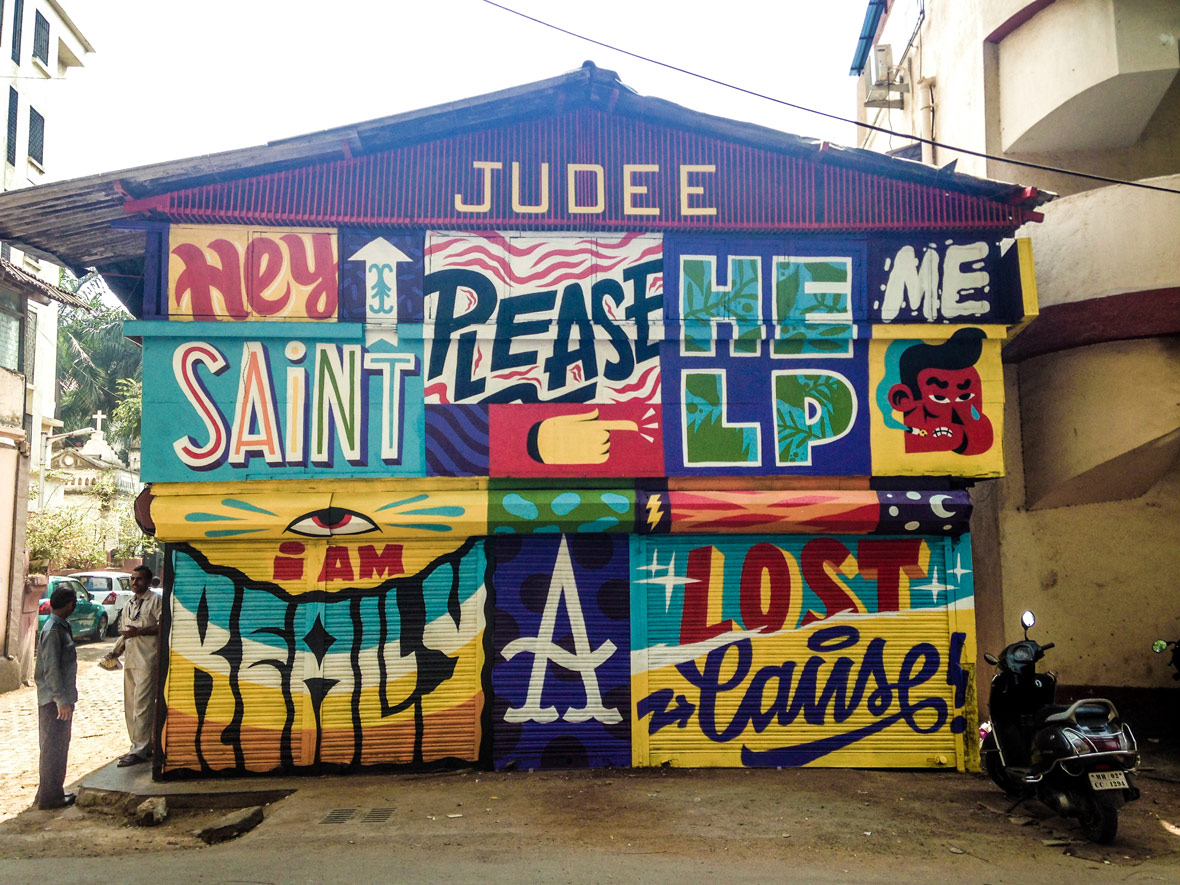
With the belief that an artistic exchange is key to begin a dialogue between different cultures, St+art has brought in many international street artists to create alongside local talents over the last three years, including invitees from Spain, France, Serbia, Japan, USA and more. They converse with potential international artists months prior to the project, briefing them on nuanced aspects of Indian culture and describing the location they’ll be working at. “This exchange is fundamental to open up minds and create fluidity in each art piece, for both international and Indian artists,” Ambrogi explains.“We try to make the pieces relevant for the people who eventually are the owners of the work, but on the other hand, we also try to create something that is unique and responds to the environment in which and for which it’s been created.”
St+art 认为艺术的交流是开启不同文化对话的钥匙。在过去三年,他们邀请了来自不同国家的街头艺术家与本地艺术家一起进行创作,受邀者分别来自西班牙、法国、塞尔维亚、日本、美国等地。在项目开始之前几个月,他们会与可能合作的来自全球各地的艺术家进行讨论,向他们详尽细致地介绍各方面的印度文化,说明要进行创作的地点。Ambrogi解释道:“这种交流是开阔思维的关键,让每一件艺术作品充满流动性,对于其它国家的艺术家和印度当地的艺术家而言同样如此。我们试图使每一件艺术作品都能与它最终的拥有者存在关联性,但另一方面,我们也在尝试创造独一无二的作品,使其能反映出它创作所处的环境,而艺术作品也正是为这些环境所创造的。”
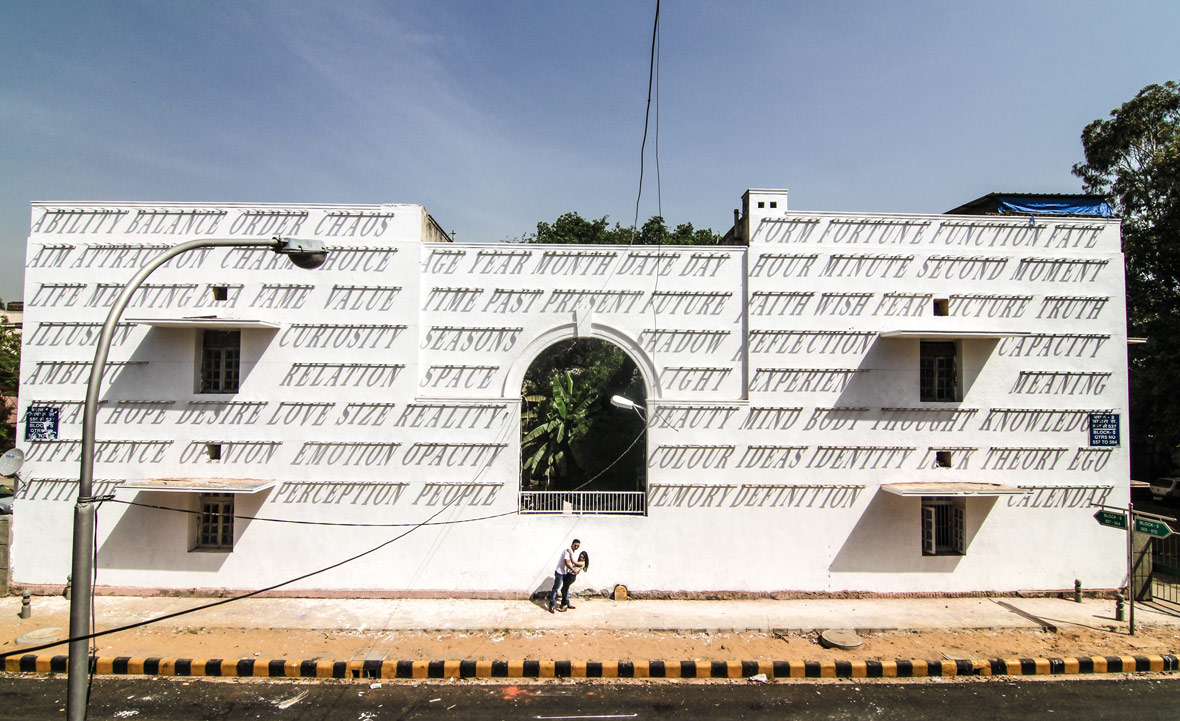
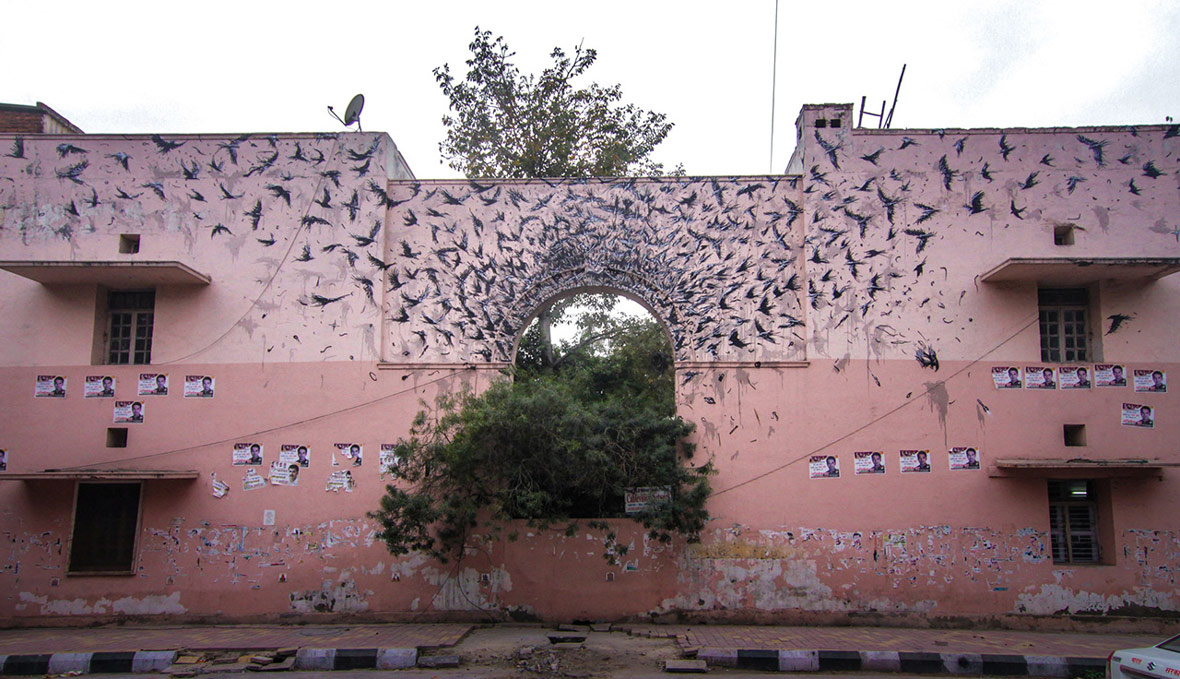
Besides Delhi, they brought the festival to Bangalore and Hyderabad last year. “We chose Bangalore for two reasons: on one hand, it’s home to most Indian street artists and is also a fairly receptive city for all things, underground and others in term of art and culture. The other reason is thanks to Amitabh Kumar, one of the artists who is always with us in our festivals and who runs a brilliant project called ‘Art in Transit’ with the Srishti School of Art, Design, and Technology, one of the pioneering art colleges in India.”
除了德里,他们还在去年将这一街头艺术节引入班加罗尔和海得拉巴。“我们之所以选择了班加罗尔是基于两个原因: 一方面,这里是大多数印度街头艺术家的聚集之地,在艺术和文化方面,这座城市对所有事物的包容性比较好,包括地下文化等等。另一个原因是其中一名艺术家—— Amitabh Kumar,他一直都有参与我们的街头艺术节,还与班加罗尔的 Srishti School of Art, Design, and Technology 学校一起经营着一个很出色的“Art in Transit”艺术项目,这所艺术院校是印度的顶级艺术学院之一。”
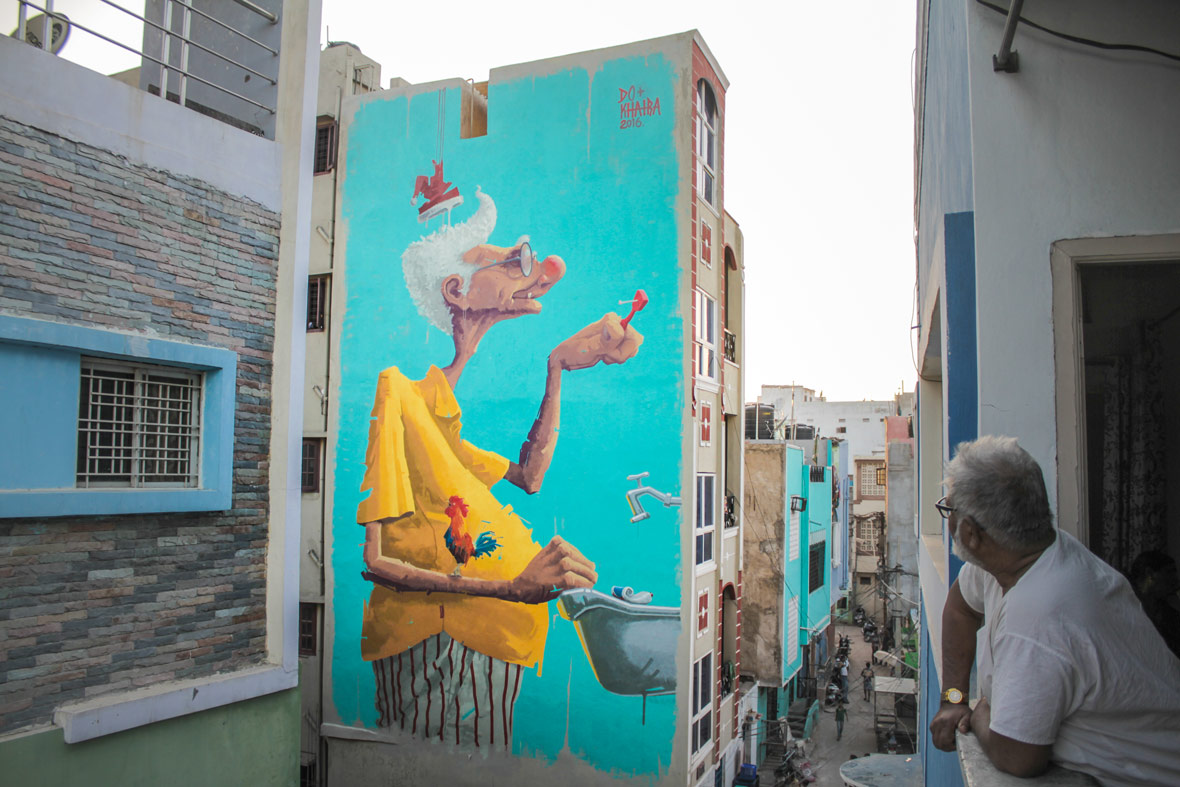
“As for Hyderabad, it was the first time in which a state government approached us to do our street art festival,” Ambrogi says. “We found it to be a perfect location. Being the new capital of Telangana, it’s seeking out a new contemporary identity for itself. It’s a city that is looking towards being a smart city, the next big hub for technology and culture. It’s led by open-minded and progressive politicians.”
Ambrogi继续说道:“至于海德拉巴,这是第一次有政府主动联系我们去举办街头艺术节。并且我们发现这里真是举办艺术节的完美之地,作为特伦甘纳邦的新首府,海德拉巴正寻求一个现代化的身份,成为一座智慧城市与下一个科技和文化枢纽。而带领这座城市的正是有着开放心态和进取精神的政治家。”
In every city that St+art has passed through, the reception has been highly positive. But when their projects take place in areas where art and culture are especially lacking, such as Lodhi Colony and ICD in Delhi or Maktha in Hyderabad, they notice a much larger and longer lasting impact. Beyond their original goal of democratizing art, St+art‘s deliberate location choices are attempts to initiate a dialogue about the changes taking place in many of these cities, which include societal issues such urban neglect and gentrification. In October of this year, St+art India will be bringing their festival back to Mumbai; as part of the festival, they plan to invigorate Dharavi – notoriously known as the largest slum in Asia – by reshaping it into an art district much like what they did for the Lodhi Colony. St+art also has plans of introducing urban design and other forms of contemporary art for this year’s festival to provide an even more well-rounded experience for all attending.
St+art在所到的每个城市都获得了很积极的反响。但当他们在一些艺术和文化极其匮乏的地区——譬如德里的 Lodhi Colony和 ICD,或者是海德拉巴的马卡塔——举办他们的艺术项目时,他们发现这些艺术项目往往能带来更大更持久的影响。除了最初创造大众化艺术的目标,St+art的特意选址是要试图引发有关许多城市所发生的各种变化的对话,其中包括对城市的忽视和中产阶级化等社会问题。 在今年 10 月,St+art India将再次回到孟买举办街头艺术节,作为艺术节的一部分,他们计划复兴达拉维地区——亚洲最大的贫民窟,它正在如Lodhi Colony一样,被改造成为艺术区。St+art还计划为今年的街头艺术节引入城市设计和其它形式的当代艺术,为参与者带来更全方位的艺术体验。
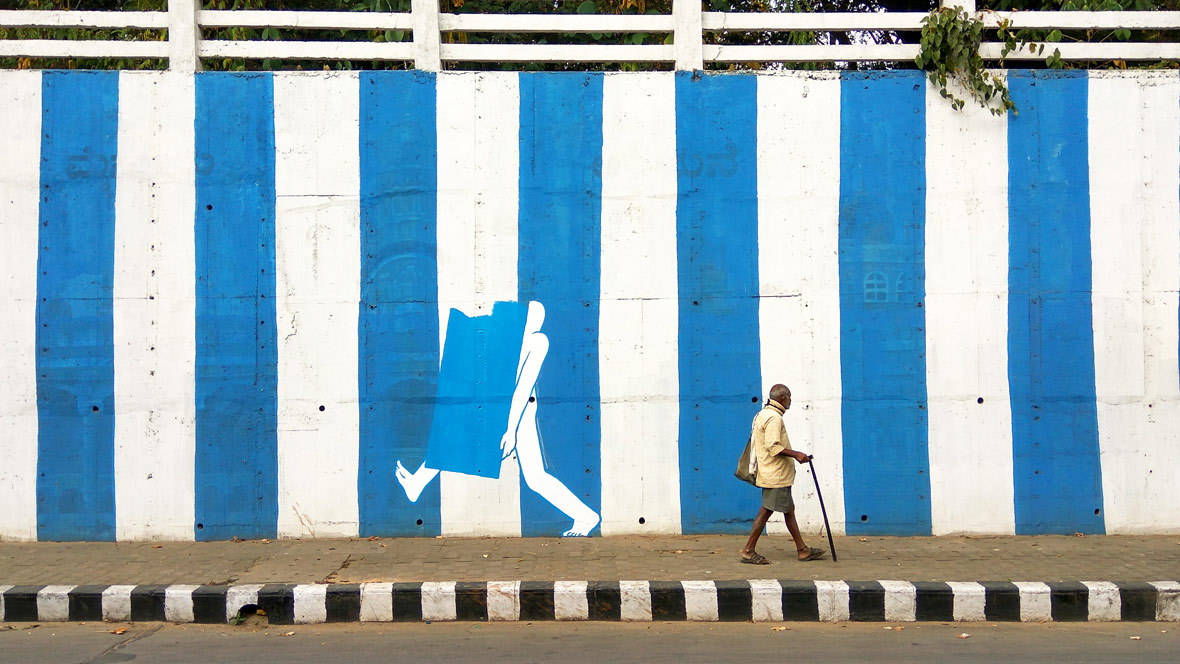
Website: st-artindia.org
Facebook: ~/startindiafoundation
Instagram: @startindia
Contributor: David Yen
Images Courtesy of St+art India Foundation, Asian Paints & Enrico Fabian
网站: st-artindia.org
脸书: ~/startindiafoundation
Instagram: @startindia
供稿人: David Yen
图片由St+art India Foundation,Asian Paints与Enrico Fabian提供

